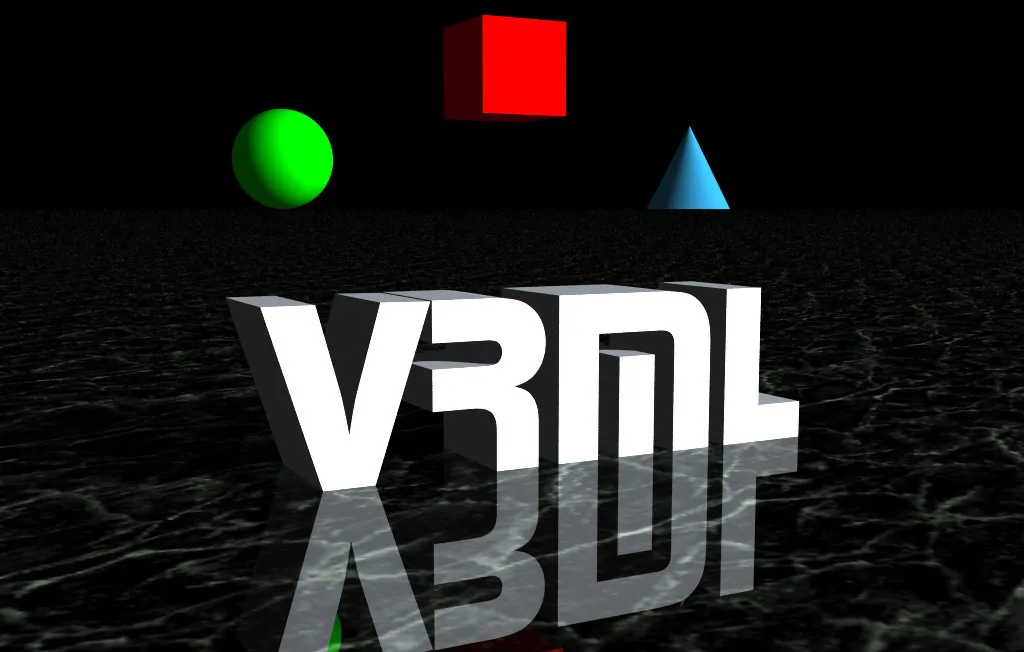Virtual reality is here to stay. It is showing up everywhere – from taking center stage at the Game Developers Conference (GDC) in San Francisco this year, to making a splash at the VRLA Spring Expo in Los Angeles, California. Practically everywhere you look, VR is sliding in to alter every industry it touches; but where did it all come from? Why is virtual reality proliferating now like never before?
In a series of interviews and re-publications, we venture into the past to see where this exciting virtual reality ride began. Today, we interview Tony Parisi who is best known as the co-creator of the Virtual Reality Markup Language (VRML) developed in the 1990s. He has been living in San Francisco for the last 20+ years. When Parisi first arrived, he got involved with virtual reality almost as soon as his feet hit the ground. He started working on software technology called VRML, which was the first attempt to transmit 3D graphics over the internet so that anyone could experience it in a browser. Parisi is passionate about 3D visualization and has working in that field ever since. Now that VR has resurfaced in a big way, Parisi has taken a keen interest in it again and is currently working on a virtual reality startup in San Francisco.
We caught up with Tony Parisi at a virtual reality-focused event called the VRLA Expo in Los Angeles, California and recorded a 40+ minute interview. The video is posted at the end. The following transcript is a discussion that takes us back in time to one of the high points in VR during the 1990s. Topics of conversations include the development of VRML, virtual reality meetups that occurred at the time, notable influencers of the culture, current webVR technologies, the bandwidth needed for virtual reality experiences streaming through servers, some potential input solutions for the web, security implications, and much more.
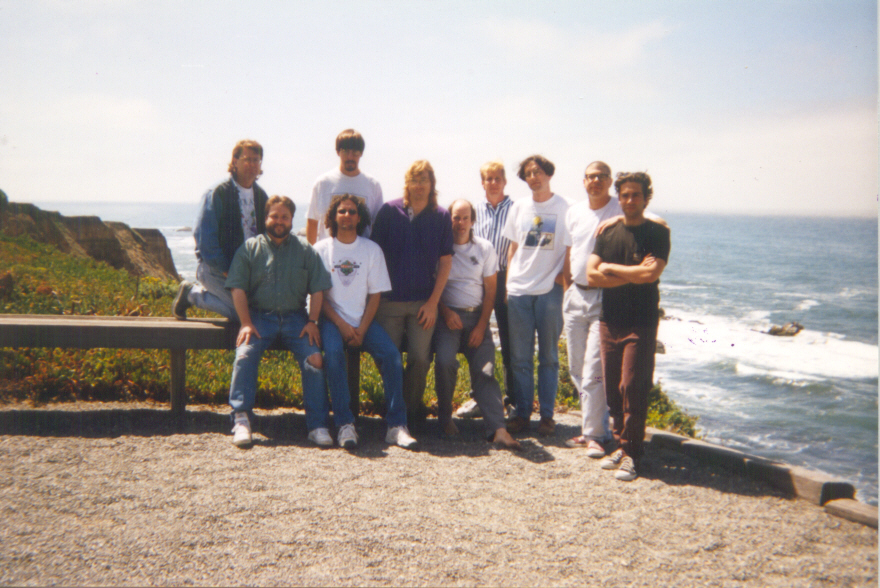
So Tony, what got you into VR to start?
I’m a person who is really a believer in visual interfaces. I had always been working in user interface software. I had been in the field for about 5 years already as a professional software engineer, and then I met a fellow named Mark Pesce. I met him through some mutual friends; I’m from New England originally, and so was Mark.

My wife and I moved out to San Francisco in 1993. We looked up Mark just to try and know some people locally. He laid this idea on me. He had been coming out of a virtual reality hardware startup called Ono-Sendai, named after the famous Ono-Sendai in Neuromancer, which was a technology company creating VR hardware. That didn’t work out so well for [Mark], but he still was a believer in this metaverse idea, and the World Wide Web was just coming out. 1993, there was a browser called Mosaic, which is the predecessor to Netscape, which became the first big internet browser. Mosaic came out of a university in Illinois—the University of Urbana-Champaign, where Marc Andreessen worked. Mark Andreesen created the first big web browser called Netscape. He moved to Silicon Valley, investors gave him a bunch of money, and the web took off.
While the web was taking off, Mark Pesce cooked up this idea: “hey, let’s put 3D graphics into it. PCs can do 3D graphics now.” At the time they really couldn’t. They were doing everything in software, it was really slow, graphics were really primitive. We were still getting on the internet using dial up modems, but we actually made the technology work. We created a demo called Labyrinth which let you browse the web with some 3D graphics connected to it. And that was the beginning of what came to be known as VRML.
VRML stands for “virtual reality markup language,” correct?
Yes. It’s been alternately known as virtual reality modeling language as well. I’m retconning it, if you will. I’m just going back the original markup language term, because that was the original term for it. At this point, that’s what matters to me, so I go with markup.
You were working with Mark, and were there other people in your team?
Mark and I were a team building that demo. And then, Mark discovered there was a World Wide Web conference happening, actually the first ever World Wide Web conference happening in Geneva, 1994. And there was a call for proposals for various topics. A fellow named Dave Raggett, who is working with W3C (the World Wide Web Consortium) for the prototype for that; I don’t even know if it was so named in 1993. Raggett put out a call for proposals for virtual reality.

Mark discovered [the proposal], we submitted to it, and we were invited to come present our work in Geneva, 1994. We just sent Mark because we didn’t have enough cash to afford two plane tickets. So we put him on a plane, and he went out there. Dave had this birds of a feather session, and people got together in a room, the size of a hotel room like this, to talk about the topic. Dave said, we’re looking for people who are building virtual reality interfaces, thinking about how we could make that a standard for the web.
And Mark got up, with his typical bombast; and if you know Mark, you’ll appreciate this: he said “We’ve already done it.” And he showed a demo, and what he showed was a demo on a PC of, it’s kind of comical in hindsight, a spinning banana. It was the only model we could find for free in an OBJ file format. We got the banana spinning up on the screen in a little PC program called Labyrinth, and when you clicked on the banana, it launched you into a webpage. So that was the first technology proof you could connect 3D graphics to the web.
So the program was called Labyrinth, and the demo was the banana?
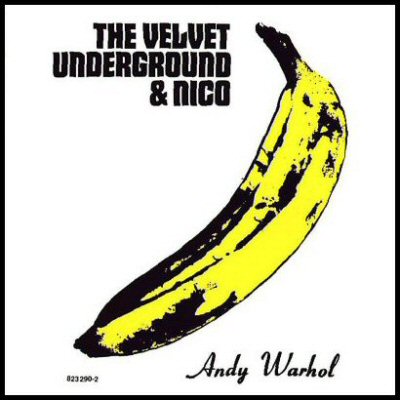 The banana. And it was a banana in typical 3D graphics of the time, against a blank black screen; which is kind of hilarious because I realized about 20 years later as VR was taking off again, I drunk dialed Mark about a year ago. I said, we just got the background color wrong. If it had the white background color, it would’ve been the cover of the Velvet Underground & Nico album.
The banana. And it was a banana in typical 3D graphics of the time, against a blank black screen; which is kind of hilarious because I realized about 20 years later as VR was taking off again, I drunk dialed Mark about a year ago. I said, we just got the background color wrong. If it had the white background color, it would’ve been the cover of the Velvet Underground & Nico album.
So that was the thing, and to me it’s poignant because we’ve always been approaching this as technologists, but it really is an artistic medium in so many ways. I couldn’t help but thinking that if maybe we had the background colored white it would’ve pushed VRML farther faster, at least with the artists.
Interesting. So Dave Raggett also put in a paper at the first World Wide Web Conference, and Wikipedia says that he coined the term VRML. Does that sound right?
That is correct. He came up with the term. Yes.
From there, what happened? It seemed like a lot of people started using VRML for a few years. One person said Nickelodeon had a little bit on there. What other companies were using it?
So 1994 ended up getting pretty frothy, if you will, for the web. There was an explosion of web things. At the end of 1994, that’s when the company Netscape was formed around Marc Andreessen’s browser technology who is doing work at Mosaic. All of a sudden, everyone wanted to do some kind of web startup. VRML was in that conversation. There’s a company that’s still in existence but has fallen from being a very large company, a multibillion company at the time. Silicon Graphics, had high end graphics work stations and was starting to experiment with graphics in PCs as well.
They heard about VRML, and they got involved in the project. The next significant thing that happened was Mark Pesce and I teamed up with Rikk Carey and Gavin Bell from Silicon Graphics. They had a software tool kit for doing 3D graphics called Open Inventor. We decided to use Open Inventor as the basis of what eventually became VRML.
The first piece of really cool VRML content that was created, we partnered with a 3D production studio and Intel to do a fly through of the graphics chip they were starting to promote which was then called the Pentium.
So to go from our Labyrinth prototype to actually a format you can publish 3D graphics in, we partnered with the Silicon Graphics on that, and Silicon Graphics started running with it and promoting VRML a lot in their PR. This was early 94, 95. There was so much attention on it that I started my own little startup in my garage called Intervista Software, and I had the first PC-based VRML viewer.
I got some seed investment and started a company around that. VRML took off, there was a lot of hype around it from 1995 through 1997. Every major company technology was into it. Netscape was doing something, SGI, Silicon Graphics, Apple, Oracle, IBM, Intel. Everyone was involved. The first piece of really cool VRML content that was created, we partnered with a 3D production studio and Intel to do a fly through of the graphics chip they were starting to promote which was then called the Pentium. I don’t know, your phone can probably do like 100 Pentiums worth of processing now, but at the time it was the big thing from Intel. We did that as a marketing piece, and that was part of the flurry that was happening.
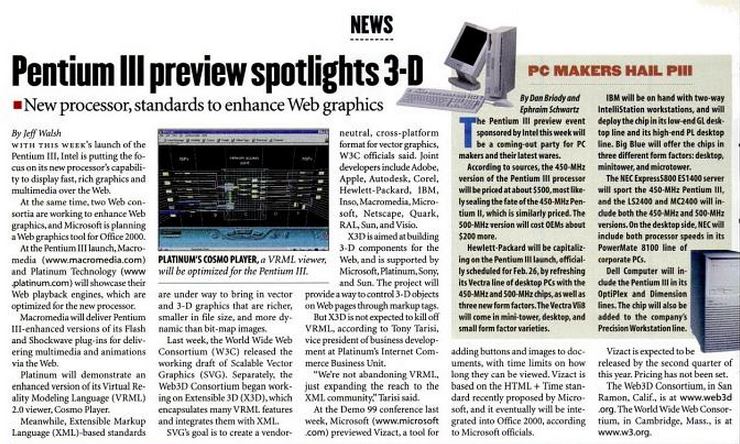
Microsoft got very interested, and my company partnered with Microsoft, and our World View viewer was actually distributed with Internet Explorer for several years. We had about 10 million copies of World View installed on PCs worldwide, which was a pity though because people weren’t really ready to create content for it yet. There was a big gap between what people could do as a business with it. You had to install a plugin. In the case of Internet Explorer, our plugin came with it. Shipped on a disk. You know how they used to ship software on disks? This was pre-download. You had to actually press a button to install it. So there was a lot of friction to having people get the 3D experience in the browser.
And content creation at that point for the web, imagine you got on one side people doing high end 3D animation, or beginning to do 3D graphics for games. 3D games like Doom were just coming out; Doom and Wolfenstein, very early John Carmack stuff. On the one hand, there weren’t that many people versed in creating content for real time 3D, and nobody versed in publishing that to the internet. On the other side, anybody doing development for the internet, they were just trying to get their brains around how to make web pages. So the whole thing fell into a chasm eventually.
3D games like Doom were just coming out; Doom and Wolfenstein, very early John Carmack stuff. On the one hand, there weren’t that many people versed in creating content for real time 3D, and nobody versed in publishing that to the internet.
The tech companies were overspending, building these products in the market, just not being ready. Not to mention again, the computer clock speeds were measured in megahertz, not gigahertz. People were still not connecting with a broadband connection. Yeah, they were using modems. It was all kind of early on the technology infrastructure side. We weren’t in a place where everybody had the internet. It was drastically different 15 years ago.
The browsers that were being used included Arena and Netscape. What other browsers were being used then?
Internet Explorer. So after Netscape made a big splash, Microsoft got into the business pretty quickly. They eventually outpaced Netscape. They were the dominant browser in the early 90s, until Firefox came along. That was a reboot from Netscape, actually, from the same organization. Then Chrome came in and randomized the mix a little under a decade ago. But at the time we were doing it, it was Netscape and Internet Explorer primarily.
Okay. You’ve been doing a few presentations on webGL, recently. In those, you talk about how there were meetups and conferences happening in the 90s that are somewhat similar to what’s happening now. Who was organizing those, and what were they like?
So, there was no formalism like meetups. There was no websites you could go to like meetup.com where you could press a couple buttons, broadcast, and start a meetup group. It was very much through random bulletin boards online, where people were saying that they were going to do an event.
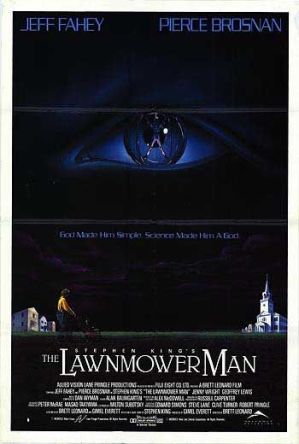
It was primarily software bulletin boards. It was BBS text based systems pre-web. There was a big one called VeRGe, started by Linda Jacobson and Timothy Childs back in the mid 90s. VRML was a big part of those meetings, and they talked about other virtual reality topics as well. It had very much the feel of VR meetups that are happening today. 50 people in a room, all kinds of enthusiasm about the future. Like, “This is the future, we’re going to disrupt everything, we’re all going to be in the matrix soon.”
Brett Leonard would show up, and we were all talking about his new video Lawnmower Man. Of course, everybody in the room had already read Snow Crash and Neuromancer; we were steeped in it.
At the same time, there was a lot of trade show activity around the internet, and VRML was a big part of that from 95 to 97 or 98 when we were hitting this down turn. The expos and conferences we are seeing now for VR are very much reminiscent of virtual reality hardware conferences that pre-date VRML. Again, so Mark Pesce came out of the early crop of VR startups from the early 90s. It was very similar feel to what we’re seeing now.
People were excited about the VR possibilities, but there was no way economically it was going to get into consumer’s hands at that point; which is what lead to that early crash of VR.
Of course, the price tag on all the hardware had two extra zeroes on it. The software was much harder to deal with. We’re talking about a radically different deal here. People were excited about the VR possibilities, but there was no way economically it was going to get into consumer’s hands at that point; which is what lead to that early crash of VR. It was too much, too costly, too hard to deal with. We didn’t have supercomputing in our pocket like we did now. Everything is different. But the feel is very much the same. Lots of déjà vu for me, when I attend these events now.
It sounds like the community seemed kind of similar to what is happening now; people with like minds coming together, just wanting to explore, provide feedback, and stuff like that. You also said that hardware-based trade shows and conferences were going on. So, was virtual reality organizing its own events? Was it virtual reality specific or were these hardware parts of virtual reality in a subset of larger conferences?
Both. Before the early VR bust of the 90s, there was VR World Magazine. There was a VR World Expo by a company called Mekler Media. I’m not sure they’re even in the trade show business anymore. I’m telling you, it is déjà vu. There’s was an entire industry springing up, like what we are seeing now with VRLA, SFVR, SVVR and UploadVR, for example. So it is oddly reminiscent of that. Numbers wise, it’s bigger now. It’s bigger in terms of people, it’s leaner in terms of it’s easier to put an event together now. They’re starting to scale up to be big business.
It’s very similar.
The expos and conferences we are seeing now for VR are very much reminiscent of virtual reality hardware conferences that pre-date VRML.
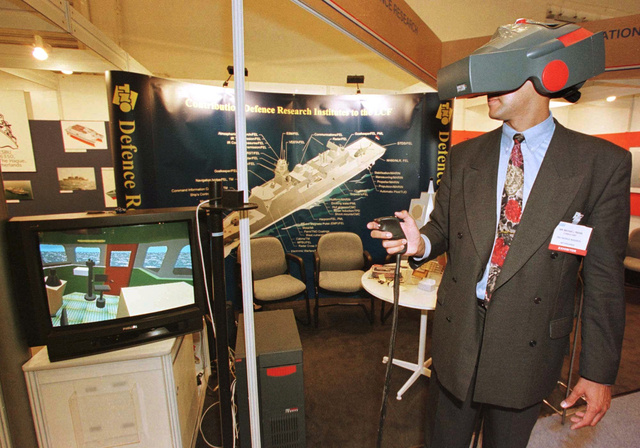
Continue reading on Page 2
UploadVR’s “Flashback” series is an ongoing effort. We are looking for virtual reality pioneers who worked with VR in the 1990s and before. If you are one of those people or know someone who is, email Matthew Terndrup at terndrupm@gmail.com to arrange for an interview.
Were there small after parties going on?
There were after parties. I don’t know about the size of them, I can only speak to the ones I went to. But yeah I mean, I was your age when this was going on back then. And so, I could go on without sleep for a couple days and there was a lot of partying happening.
On a press side of things that were going on at the time, you guys were on the cover of Red Herring, which said “VRML: The LSD of the Internet.” Was there other press covering virtual reality at the time?
Yeah. There was a big Wired article that came out even before the Red Herring, which was interesting. We weren’t the cover story.
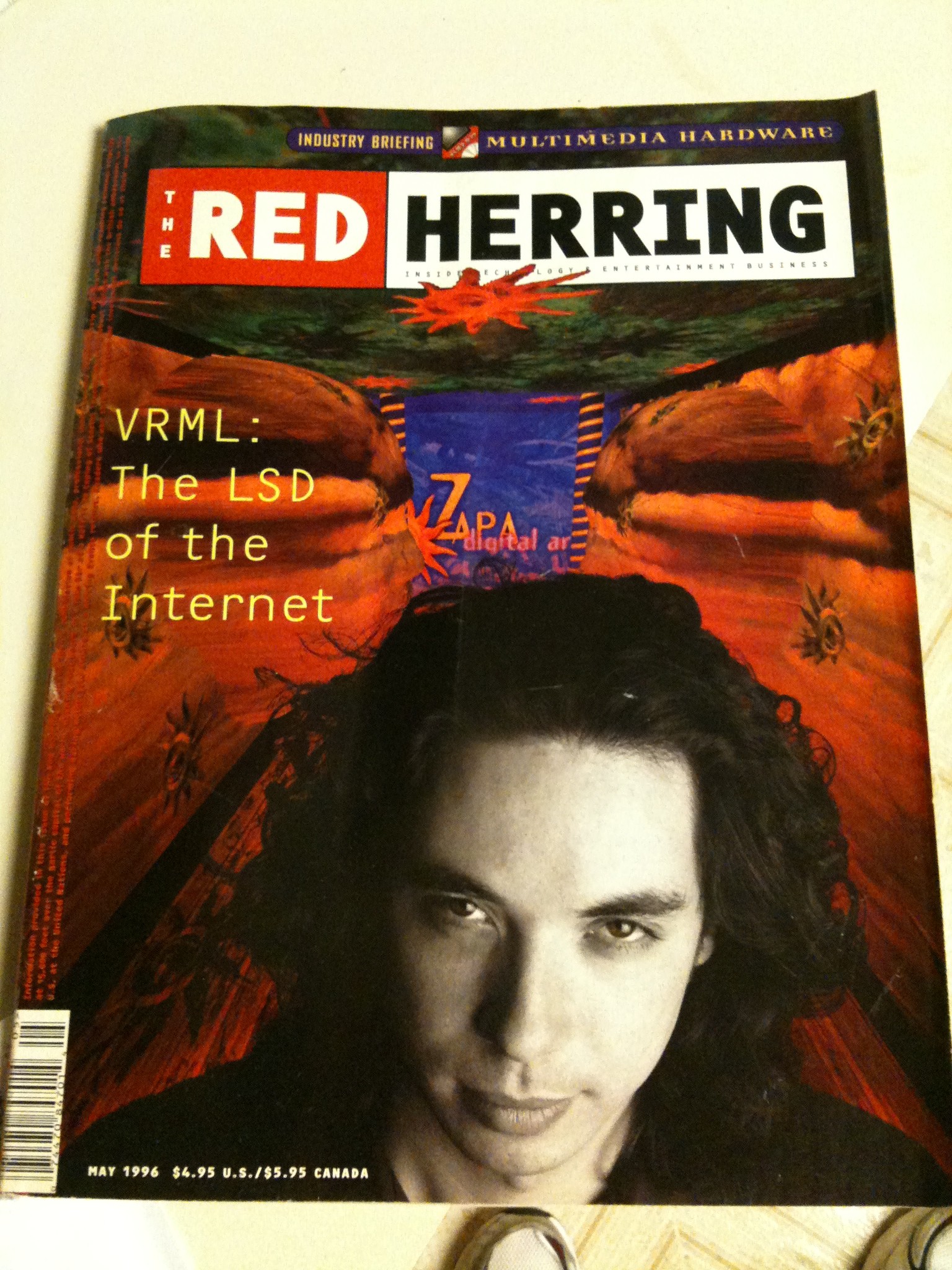
It was Richard Dawkins, the evolutionary biologist, very well known, was talking about his book The Selfish Gene—I’m a big fan of Dawkins. Anyway, there was a main story in there written by a man named Erik Davis who is a great writer on California, psychedelics, and consciousness in fact.
That article was called Technopagans, and it covered a wiccan ritual that Mark Pesce and I created that had VRML work stations around it at the four cardinal points, and it was a live wiccan magic circle we had done. Erik wrote it up as, “technopagans – May the astral plane be reborn in cyberspace.”
Eric wrote that up, and I’m like, “oh shit, I’m about to go try and get investment money, I’m doomed.” It did not seem to put anybody off though. There was paganism and alternate religion going on around this stuff time too. That was some of us biggest ink at the time.
Was Mondo into it?
Mondo was all about this. Mondo was writing about psychedelic drugs and virtual reality and everything that stems from that and the whole world changing. They were big for a few years and big fans of VRML. I’m sure they covered it, but I can’t recall specifics.
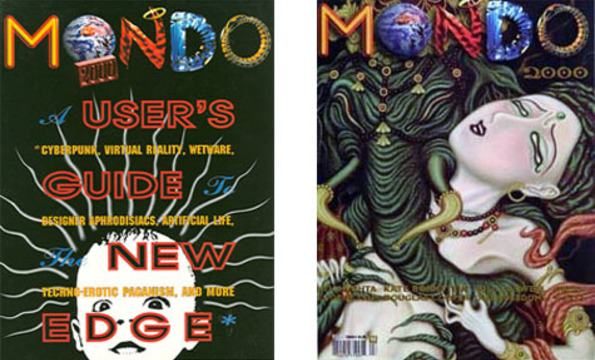
Was Ted Nelson showing up to these events?
Ted Nelson had created this hypertext system that predated the web called Xanadu. During the early VRML days, when we were doing what all these folks are doing here now at VRLA, getting everybody all excited about it, Ted Nelson would come up on panels and be an old curmudgeon, about how Xanadu was. He would be like, “I had this all figured out 20 years before.” He really did, but it is really all about timing.
If I was to be the Ted Nelson of this time right now, I’d be going up on a panel here, and I’d be going like, “oh I had this shit all figured out 20 years ago.” Thankfully, I feel a little more humbled than that. I’m actually still super enthusiastic about it. The fact there’s a whole new generations of folks putting effort to it, and I’m still alive relatively young. I can actually take another run at this again too, personally. I’m humbled I have another chance to do this. In Ted’s case, he was like, “yeah. What is this stuff? you kids.” Props to him, I’m not complaining! If anyone can grumble about it, he’s earned the right.
Was Jaron Lanier hanging around you guys too?
No, so after VPL, which was his startup, we didn’t hear too much from him. We was around there, but a couple of the knee jerk sort of reactions was, “This is all low PC. There’s no headsets, no headsets! This is just all flat screen.” Jaron‘s thing has always been about the immersion of VR, and that VR is a creative medium connected to that. Where you know, VRML when it was getting a lot of press and attention, it was people spinning models of cellphones in pages to try and see if you could sell products that way; like some of the VR stuff we’re seeing now. So, I don’t think it was Jaron’s cup of tea.
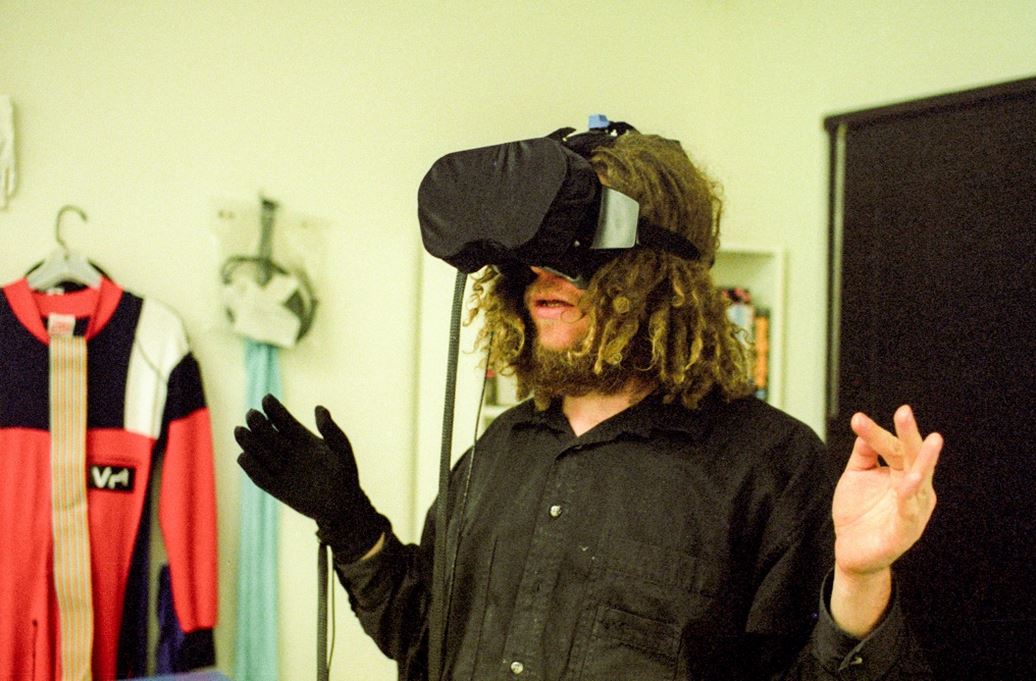
Alright. Let’s travel through time. From the time you were working with VRML in early 90s to now, what happened with you personally?
After VRML, I took a little bit of a break from the 3D stuff. I had a few arrows I had to pull out my back, as they say. Those wounds healed. But me personally, I couldn’t stay too far away from visualization. I’m really passionate about 3D. So, the group that had been working on VRML continued. They continued to this day actually working on something called X3D which is a successor to VRML, just graphics interchange. I was actively involved in working on X3D a little bit; kind of as a side project, passion project. Then I started up another startup, Media Machines, that was doing another in browser plugin with all new graphics because VRML graphics were really crude.
Now at this point we’re talking 2002, 2003, 2004. Now most people had a graphics card. Computers were quite a bit more capable. Broadband was in those houses already. I was thinking that this was may be another time to take another swing at doing 3D on the web as a new vehicle for communication. I started building this general payback system for 3D, sort of like the Unity engine, but it wasn’t oriented towards game development. It was just 3D player stuff. You could do an architectural walkthrough, webpage, or grab objects, move them around, do collaborative buildings; those kinds of things.

And then something happened. Philip Rosedale started Second Life, the virtual world. That was this giant program, this big download, this installed thing in a PC, and kind of hard to use, but I played with it. The avatars were cool. I really just liked flying around. I never got into all the other stuff. Never got into getting virtual lap dances from avatars who were probably operated by guys on the other end by the way. I’m not going to pay him 5 bucks to get a lap dance. [A virtual lapdance were you don’t even get any haptics or anything].
That wasn’t too interesting to me, but I thought that it was pretty cool. I thought, “what if you could do that second life experience with a really quick browser plugin download, like 3 megabytes instead of 100 megabytes at a Second Life client. What if you could connect that up to all your web data?”
That ultimately became a startup that I got significant funding from two Silicon Valley venture capital companies. It got renamed to a company named Vivaty. It was an in-browser virtual world. Our goal was that we were going to compete with Second Life. We had avatars. We had beautiful environments. We had a virtual goods system. We had about a million users, and then the 2008, 2009 tax recession hit. We weren’t making money yet. We were going to have to go out and raise another 10 million dollars to build this out.
Our goal was that we were going to compete with Second Life. We had avatars. We had beautiful environments. We had a virtual goods system. We had about a million users
We weren’t proving out the money side of it yet, but we had a lot of usage. At the same time, along came Zynga with their cute puppet game avatars for café world that didn’t require an extra download. You just sat there and cook virtual food in Flash. That got a lot of attention, but no one was spending in the investment community in 2008, 2009. But by 2010, we sold Vivaty to Microsoft, and then Zynga started taking off.
If the timing had been different, maybe Vivaty would have been a big large scale virtual world. Again, it still required an extra download of software, like a plugin like Unity used to require. So this is all pre where we’re getting to I assume which is what webGL changed in the last four to five years, that was just about five years ago.
So when Second Life came up, were people using VR headsets and HMDs with it?
No, that was all desktop, flat screen.
Even VRML had no interaction with headsets?
There were research groups and universities connecting VR high-end equipment to VRML. Maybe there’d even been experiments with OpenSim, which is the open source version of Second Life , but they were never prevalent.
In terms of the webVR, which is kind of came full circle back around, would you say this is now the first time where people are using headsets to explore what people are calling the metaverse?
Yes. Absolutely. There’s two things going on. There’s the deep VR experiences we’re seeing a lot of, like in a Unity game. You’re just shooting things, exploring this rich world, that’s all great. It’s essentially a solitary experience, you download about 300 megabytes of stuff, install an application. The best it gets is pretty good, which is with the Samsung Gear VR, which is still an expensive proposition, but hopefully the price comes down.
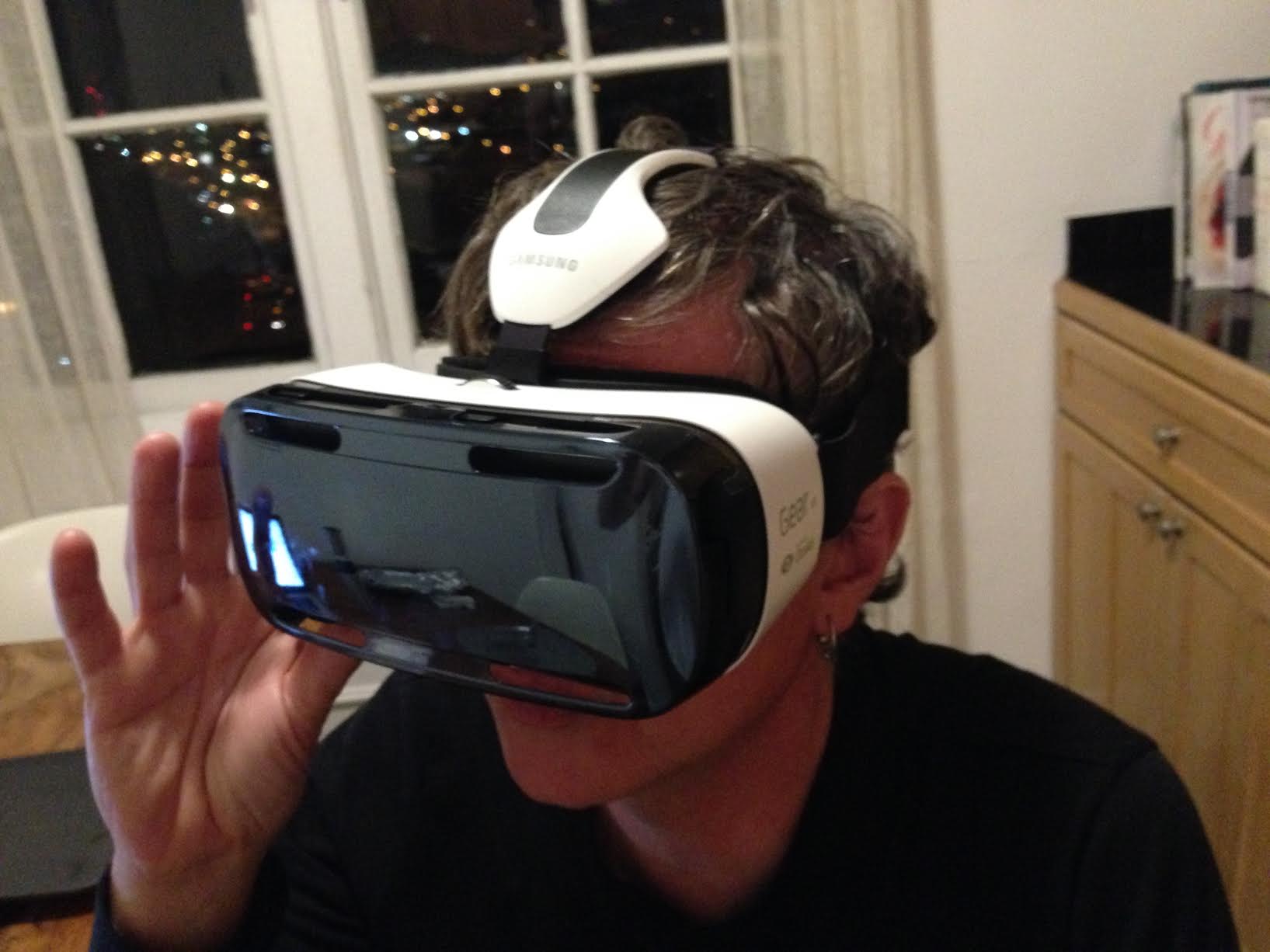
You still have to install about 300 megabytes of an app, and that’s an app. When you’re done with that app, you are done. But then, what if you could connect a web browser to the Oculus Rift, or Gear VR, of the Cardboard VR, or any headset? The Vive headset too, that’d be awesome. What if you could connect a browser to that, build applications in an easy language, JavaScript, which is what you can do, you can make all the 3d graphics? If the browser can give you the full screen stereo render and head tracking, then you could browse worlds continuously.
I could be in a world with you. I could get an alert saying so and so is over at this other place and just jump to it. I could send you an email, with a hyperlink. Then you can click on the URL, launch the VR experience, put the headset on, and good to go. So no download, no friction into getting into that experience. For developers, no friction for building it. I don’t need to learn a game development tool kit like Unity. I can do a full open source stack and create virtual worlds in JavaScript that I can browse in a headset.
That’s a pretty radical concept. We’re still at the early stages of that. Both Firefox and Chrome have support in their nightly builds, for webGL, but webVR as well. Head tracking in the Oculus stereo distortion rending are in Firefox and Chrome. Now, in the developer builds. They’re not in retail yet. If you do an upgrade of your retail chrome, you will not get this, but if you subscribe to the developer channel, you’ll get a build in Chrome and Firefox too, that supports an API. You go into full screen mode, you get the Oculus distortion. An another API that lets you write JavaScript, you pull the headset for where the position and orientation are, and they work surprisingly well.
I could be in a world with you. I could get an alert saying so and so is over at this other place and just jump to it. I could send you an email, with a hyperlink. Then you can click on the URL, launch the VR experience, put the headset on, and good to go. So no download, no friction into getting into that experience. For developers, no friction for building it.
The biggest performance bottleneck and the biggest reason there’s a little bit of lag right now, which is as we know the biggest impediment to presence, is because the browsers for years have throttled the refresh rate to 60 hertz, because they’ve had no reason to go more than 60 hertz. But as Jesus, also known as John Carmack has told us, you need to go 75 hertz at least, 90 even better, 120 even better, with your head tracking. With tricks like time warp and these other technology tricks, you can render still at 60 hertz and have time warp distort for you, but you absolutely have to respond to the head tracks at 75 hertz.
The browsers need to unthrottle, get up to 75 or 90 hertz in the refresh rate. They’re doing it, they’re working on it. Once that happens, we’re going to see pure JavaScript and HTML5 based VR experiences with no download running on parity with game engine games.

Continue reading on Page 3
UploadVR’s “Flashback” series is an ongoing effort. We are looking for virtual reality pioneers who worked with VR in the 1990s and before. If you are one of those people or know someone who is, email Matthew Terndrup at terndrupm@gmail.com to arrange for an interview.
With the webVR approach, it seems like it’s saving downloads. Right now, if I had to download a video onto my phone, it’s costing me a lot of data to get through that. Is there going to be an issue with the amount of data that are coming off these servers into these phones we’re going to have? Are we going to have to buy extra virtual reality plans through a cellphone service?
I’m sure Samsung’s data partners, and Apple when they get into the game, and all these people that are giving you the pipe to do that like AT&T will be delighted to hear that. Just the way the PC manufacturers are delighted now that I have to buy [an approximately] 75 pound laptop to run an Oculus Rift. It is going to create new expenses for us as consumers, if it does well, and new opportunities for people selling the hardware, software, services, and bandwidth in this case.
Whether you’re doing it on the web or downloading apps and video onto your phone, either way that’s data got to come over the wire and there’s going to be lots of it. And yeah, we are going to have to end up paying for it.
How much data is the web pushing out through this VR stuff right now? I’m sure it’s wifi and a wire connection.
Well, it’s the same amount of data approximately as what it would take to download the equivalent applications. It’s just coming at you instantly and streamed so you don’t have to download and install. You could potentially get to the experience quicker and then stream more stuff afterwards because you’re essentially always on this connection and didn’t have to do this click to install, say yes, and all this stuff.
Is buffering going to be a problem?
It will get solved. It will be an issue, but there are very smart people that will be there solving them; not to worry. But inevitably, you’re consuming the same amount of content. One way or another, it might be some better compression that helps it along. You’re going to consume a lot of content.
With the web browsers you talked about that you see browsers adding USB support coming up.
Yeah, I don’t know if that’s happening or not. I think it’s going to be necessary, because of course the elephant in the room with all VR is good input, and without having USB connected devices, we’re not going to have the right kind of input. So now what we’re seeing with what you can do in a browser today, if you have Leap Motion, the Leap Motion software when it’s installed, when you get the device and install the software that comes with it, it sets up a webstack and you can talk to your Leap Motion with the browser.
[Video source: Road to VR – Have an Oculus Rift and Leap Motion? Try This Web VR Demo Right Now]
That’s good to go, but that’s specific to Leap the manufacturer. That’s talking over what’s called a WebSocket, which potentially has a certain amount of latency. For the Leap experiences I’ve seen so far, it doesn’t seem so bad. For the longer term, I imagine the more input you’re trying to get with wands like that you have with the Vive or Sixense of any of these systems where there’s tons of data, or Faceshift facial recognition, these things maybe require a higher bandwidth and an intimate connection with the browser. I think inevitably the browsers will have to support that kind of input devices. It’s not clear whether they’ll support them with a generic USB device driver connection, or whether they will make specific input device types like they did with gamepads.
You can connect to PS4 or Xbox controller to your browser and write JavaScript code that the controller talks to. They built that into the browsers a few years ago. It’s not inconceivable. They could have Sixense, Hydra, Leap, and all of that stuff integrated into the future versions of browsers as devices at that level; not as a USB generic thing. We’ll see. The browser folks seem scared talking about a generic USB interface for security and other reasons.
Seems like we’re going to need to have that in order to get the input solutions that we’re looking for to explore the web through virtual reality.
Yeah, I mean, I can’t be reaching for the keyboard [all the time].
I can touch type, so I don’t have too much of a problem with it, but still most people don’t. The game controllers have been the most comfortable interface I’ve seen so far because they’re so familiar. If I give you an Xbox controller, you know what to do with it. And pretty much everybody does up to maybe grandma, but even grandma can handle it. I don’t think that’s going to be the end point.
Cool. When we start adding input solutions, say it is a USB or whatever, they can open up to stuff like eye tracking and other things like that. It allows the hackers and makers to come up and be like “what can I do with this technology?“
Absolutely. And you know that hackers and makers can take open source versions of both Firefox and Chrome and do it well in advance of them putting it into the browsers officially. That’s the other side, so you can take the open source of the browser code yourself. If you’re C++ hacker, you can go at it and add support.
I want to talk a little bit about your work with Mozilla. How did that go about? Did they reach out to you, did you go to them? How did you guys start talking about what webVR would look like?
So I was invited to speak at Silicon Valley VR’s conference last May [2014], and I was on a panel with Josh Carpenter from Mozilla. Josh and I got the opportunity a few hours before the panel that day to sit down and talk. Josh said, Vlad Vukićević, who is the engineer for MozVR and also the creator of webGL, is now working on VR interfaces in the browser.
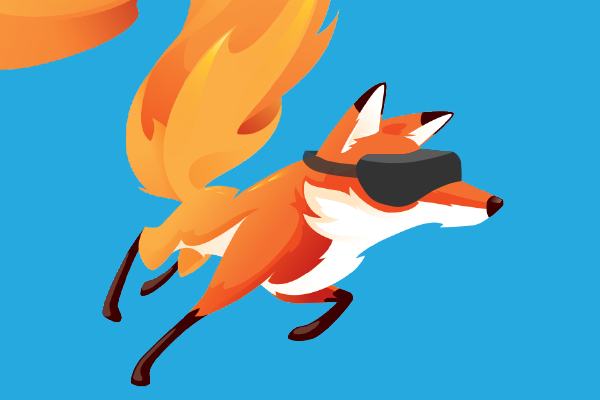
He’s got something working where it tracks the Oculus and does the rendering. You’ve got software that works in webGL, [so Josh Carpenter asked me], “are you interested in this?” I said hell yeah, this is where this needs to go. From that day, I have been collaborating with Mozilla, and my little startup in San Francisco called Third Eye has been collaborating with them from the beginning. We were part of the launch of MozVR, we put a demo up as one of the showcases.
It’s been a joy working with Josh, he’s a great guy, he’s a VR researcher, that’s his title. He’s thinking about user interface. If browsers do this someday, do browsers need a built in equivalent of back button in VR? All that user interface stuff is going to go away, it’s not windowed anymore. Is the browsers going to give developers a built in ‘back button’ and user interface controls that would be common across experiences; thinking about that stuff, and that’s great stuff to be thinking about. It’s been a joyous collaboration, working with him, and navigate those waters. It’s still very early and experimental there.
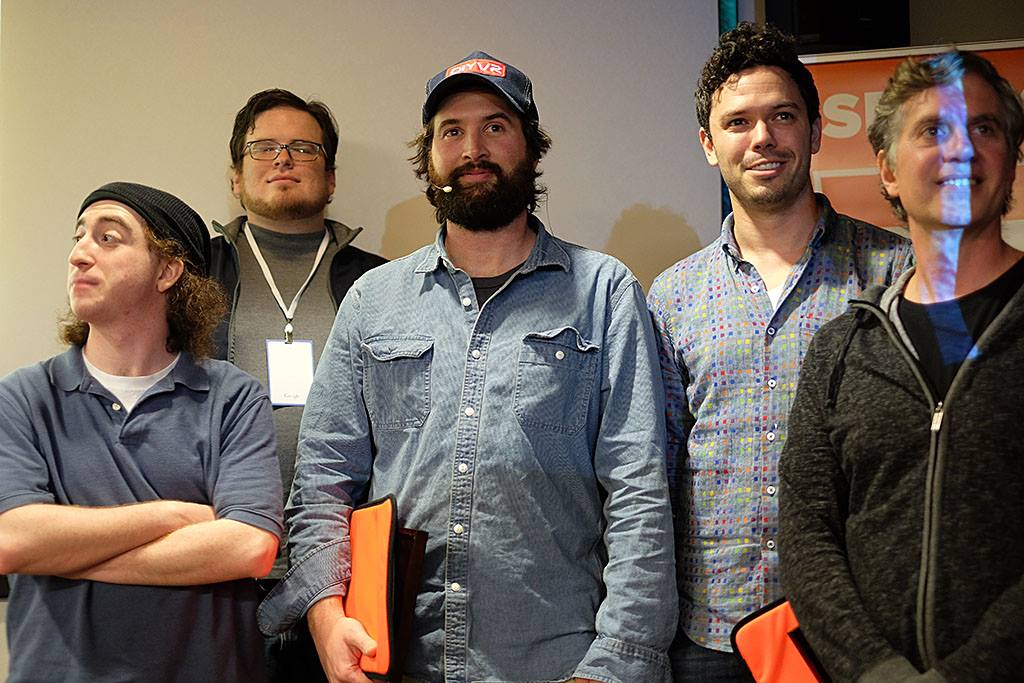
The Mozilla folks came to the first public showing of this. They did a blog posting either before or the day after a webGL meetup I held last June. I asked Josh to come and show it. I was showing webVR, but I was showing it with plugins. I was showing it with VR.js and the Oculus Bridge plugins; two kind of clunky ways to do it, but I invited Josh to come talk. He came to talk, spoke, and he invited Brandon Jones on the Chrome team. They said, “we are already working together.”
They basically had already came up with a programming interface that converged the two. So, you would write your code one way, and it works in Firefox and Chrome. They’ve been collaborating on this since the beginning, last June, and that still continues to this day. Now we have a webVR meetup group in San Francisco that is doing pretty well. We’ve had four meetups. We had a big one at Google in conjunction with SFHTML5. We had 800 people in the room, and then we busted over to the Upload event the same night. There was no webVR there, but we covered webVR. Then we got all the native big download stuff that was good. It was a big party. It was great.
What was that demo you made for MozVR?
It was called Information Diving. There’s a Russian artist named Tatiana Plakhova who created this stuff that was pure video that she had done in a video editing system of streams of information, text labels coming at you; not really tweets, but as if you were in a floating sea of information.
We tried to transcribe that as best we could with the early MozVR builds, and what we had going into the same thing. There’s streams of information and text floating at you. It was quiet simplistic, but you can check that out. It’s all on MozVR.com
https://www.youtube.com/watch?v=aeNskS5IpnM
Awesome. With the webVR operating systems, is most of this stuff coming on Linux? It seems like the servers for the most part are running Linux. As compared to what we’re seeing with virtual reality, it’s like, you know you got Apple or Windows. Nobody is using Linux at all for the headsets in the experiences that we’re having now, but it seems like the webVR completely is going to run on Linux.
Yeah, the back end of web applications will be served up primarily by Linux boxes delivering you webVR content and then running the logic for an application, whether it’s single or multiplayer. They’ll run the smarts on the back end, connect to a database or do other things.
If this is a virtual shopping application, it’s going to connect to a database that’s all on a Linux server somewhere.
What are the security limitations for web? Are people like cyber criminals going to come and find everybody’s tracking movements? Do you think security is an issue?
Security is always an issue. Big old disclaimer here, I am not a web security expert.
Most of the time when the web security experts come in, they make my life miserable because they add a prompt. Like when you want to go full screen, they add another button in the freakin’ browser, that kind of thing. They make it really inconvenient, but the point of doing that is to make sure folks aren’t spoofing their whole desktop, going full screen, then making you think you’re typing in your Gmail but you’re actually typing in some webGL app. We don’t want that to happen.
as VR becomes more popular, the cyber hackers are going to come in and they’re going to try to steal all your information. The web is going to have to keep up with that for security, and so are the native apps at some level.
The possibilities for that in VR is going to be rife. There’s going to be more of those, and as VR becomes more popular, the cyber hackers are going to come in and they’re going to try to steal all your information. The web is going to have to keep up with that for security, and so are the native apps at some level. Their jobs are easier in a certain way, but you can build a native app, you could get Apple to put it through the app store, Oculus to put it through the app store, and you could find that thing is a security nightmare anyway after the fact. Security is an arms risk. It’s always people exploiting a security hole, someone comes in and unplugs it. I wish I could say more.
With security I’m thinking, as I’m exploring the metaverse, and some guy gets access to the server that I’m in, they can open up something and create like a dinosaur in front of me and scare the shit of me; right?
They can do that with Facebook today, right? You could hack Facebook today which people have done, and do nasty stuff to your feed. Might be a little scarier if it’s 40 foot dinosaur. It’s the same level of threat.
On the metaverse side, which is a topic everybody wants to talk about, because we want to be in these different levels of the universe and computer realms or whatever. If you look at the web right now, it’s ad based everywhere. Is our future of virtual reality world going to be filled with ads?
I don’t see how they won’t be. Unless, you pay for the experiences, and those will probably will only have a couple of ads.
Some won’t have any ads.
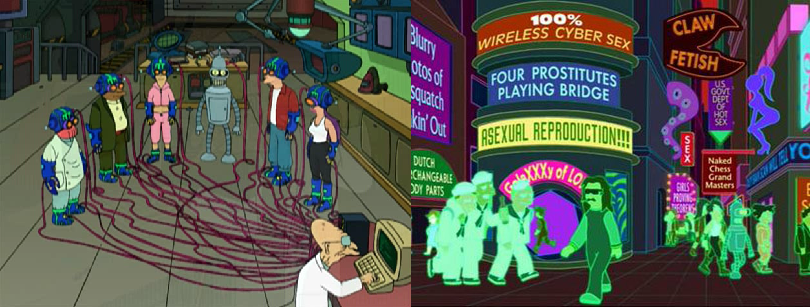
The ads are going to pay for us to explore.
If they’re free to play or free worlds, I don’t see how there’s not going to be ads or product placement to support those business models for some things. Plenty other ways for people to make businesses on the web. You go to Amazon to shop, you don’t see adds, you see the products you’re looking for.
But all the big information services, Twitter , Facebook, whoever, I mean, that’s ads. That’s how it’s driven. We’re going to see that in the metaverse as well for sure.
Does webGL and webVR also help Augmented Reality (AR)?
I would think so. We don’t know much about how the augmented reality software stacks are going to play out because what we’re seeing is the other experiments naturally. Magic Leap [for example] is not telling us anything.
 All those wonderful demos, to my knowledge, haven’t really published the API in the programmer specs, so we’ll see. I imagine there’s going to be a common thread of software. Anyone building VR today will be able to migrate those creations into mixed reality stuff.
All those wonderful demos, to my knowledge, haven’t really published the API in the programmer specs, so we’ll see. I imagine there’s going to be a common thread of software. Anyone building VR today will be able to migrate those creations into mixed reality stuff.
Where can people learn more about you if they’re interested?
TonyParisi.WordPress.com. I have a book coming out in May, maybe June, called Learning Virtual Reality with O’Reily media.
A note from the writer of this article Matthew Terndrup: If you are reading this before June 2015, you can pre-order Tony Parisi’s book ‘Learning Virtual Reality’ on Amazon.com. Click the link above to purchase.
https://www.youtube.com/watch?v=ONRW63B-4-4
UploadVR’s “Flashback” series is an ongoing effort. We are looking for virtual reality pioneers who worked with VR in the 1990s and before. If you are one of those people or know someone who is, email Matthew Terndrup at terndrupm@gmail.com to arrange for an interview.
Read More Flashbacks:
- Flashback: An Interview with Mitch Altman (A Virtual Reality Pioneer from the late 1980’s)
- Flashback: Virtual is Reality Again – Interface vs Interference Design
Bonus: An interactive version of the infamous VRML ‘Cyberbanana’

